Global and China Automotive Lighting Industry Report, 2021 combs through intelligence trends of automotive lighting, technology routes, laws and regulations for automotive lighting industry, competitive pattern of automotive lighting market, automotive lighting companies’ deployments in intelligence, and their intelligent lighting configurations for mid- and high-class vehicle models.
Global automotive lighting market is highly concentrated, and Koito is the champion.
Automotive lighting is a highly concentrated market where bellwethers play a dominant role, that is, there are “one superpower and several powers”. In the global automotive lighting market, European, American and Japanese manufacturers are the main players. In 2020, Japan-based Koito was positioned first with market share of 25.3%, Italy’s Magneti Marelli (13.9%) and France-based Valeo (12.8%) followed, three together sweeping 52% of the global market.
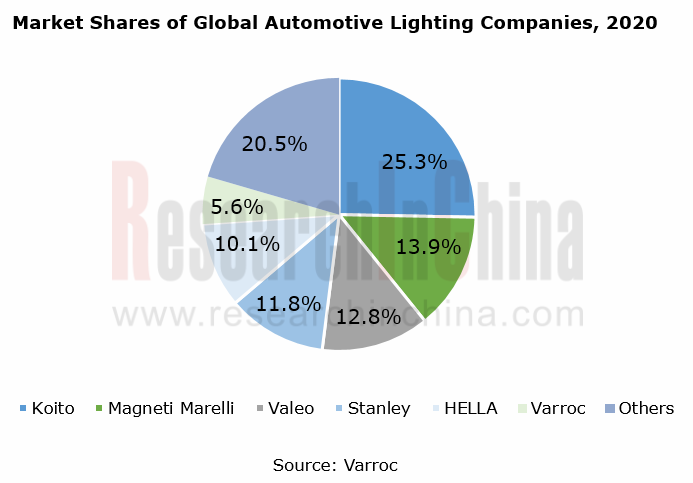
Global automotive lighting leaders vie more fiercely for new technologies:
---In September 2019, Koito rolled out BladeScan?ADB headlamp system which has been mounted on 2019 Lexus RX and 2021 Lexus LS.
---At CES 2019, Magneti Marelli introduced its third-generation Smart Corner lighting technology which can integrate with all types of sensors including LiDAR, radar, camera and ultrasonic radar. The company also displayed advanced LED lighting functions such as digital light processing (DLP) and adaptive driving beam (ADB).
---In March 2020, Hella unveiled SSL 100 light module. The system offers up to 102 pixels, each of which can be activated independently, and controls light distribution via ECU to automatically turn on and turn off LED in a designated area. SSL 100 light module has been introduced into Chinese market and mass-produced at HELLA lamp plant in Jiaxing.
---In November 2020, the Human Centric Lighting (HCL) innovator Biological Innovations and Optimization Systems, LLC (BIOS), and Lumileds, joined forces to create a new SkyBlue? LED. BIOS SkyBlue Circadian rhythm technology used in the new product is a solution to technical challenges of HCL.
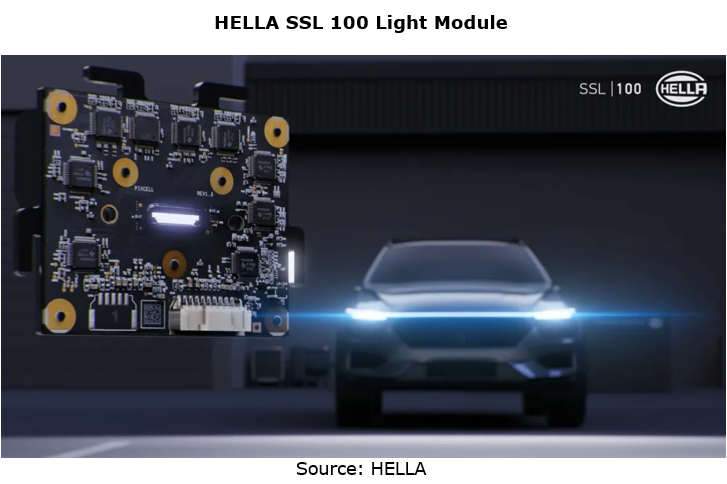
Not to be outdone, Chinese automotive lighting bellwethers have developed dynamically interactive lighting technology in the automotive CASE trend. For example, at Auto Shanghai 2021, HASCO Vision Technology displayed an intelligent interactive lighting system that consists of PML intelligent headlamps and ISD tail lights. The system can input user-defined texts, pictures and videos into the lighting domain controller which will then convert the content into elements and materials that the lamps can recognize to display the specific content and interact with the outside world. The system is mounted on Human Horizons HiPhi X. In 2020, Changzhou Xingyu Automotive Lighting Systems also managed to develop rhythmic taillights capable of welcoming, the second-generation ambient lights with public voice interaction function, gesture controlled indoor lamps, and pixel-type headlamp modules.
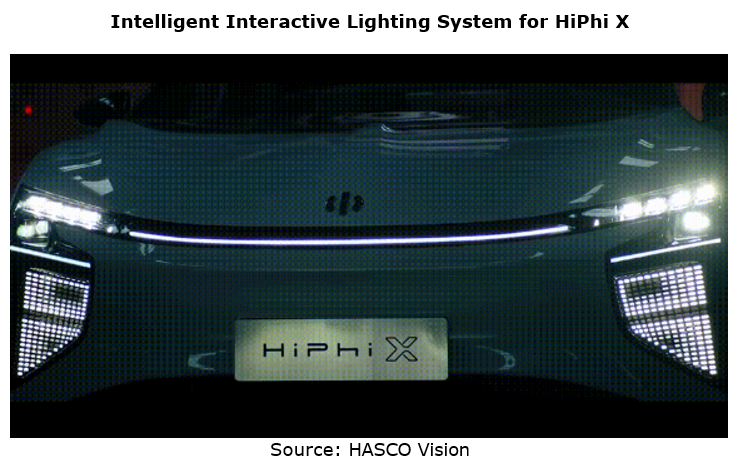
Demand for intelligent headlights increases, and six technology routes come to the forefront.
Intelligent headlights provide higher visibility for drivers in bad weathers to ensure driving safety. The data shows that the use of intelligent lamps helps to reduce 57%-74% traffic accidents at night. With the increasing demand, more and more intelligent headlights are installed in mid- and high-class cars. According to GMI Research and its public data, it is estimated that the global intelligent headlight market will be worth nearly USD6.84 billion in 2026 compared with USD4.83 billion in 2020.
There are six intelligent headlight technology routes: LED Matrix, μAFS, LCD, DLP, Blade Scan and MEMS.
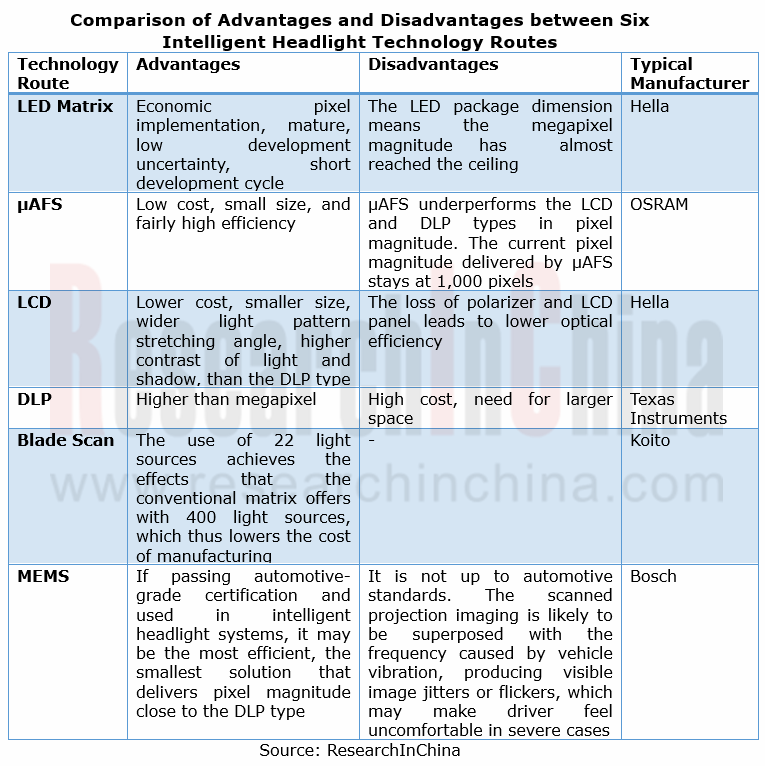
---As LED packaging technology matures and its cost falls, matrix ADB will still be the main implementation form of intelligent headlights which tend to sink from high-class car models to the lower-class.
OSRAM has introduced EVIYOS 1.0, the world’s first μAFS delivering 1,024 pixels on 4mm x 4mm SoC. OSRAM EVIYOS 2.0 offering 25,600 pixels is under development and will be rolled out in 2023.
DLP technology based on digital mirror device (DMD) is monopolized by TI. According to our statistics, there are a total of six DMD-enabled models including New Mercedes-Benz S Class, Great Wall VV6/VV7, and IM Zhiji. The more frequent interactions of vehicles with the outside world come with the development of intelligent connected vehicles. Automotive DLP technology allows light projections on ground to form various light patterns and icons so as to build a bridge to communicate with the outside world, and its high resolution helps to enable ADAS functions, for example, traffic sign lighting for recognizing traffic signs. Hence DLP technology will find broad application in intelligent connected vehicles.
Automakers play as “lighting factory” to accelerate the layout of intelligent lighting.
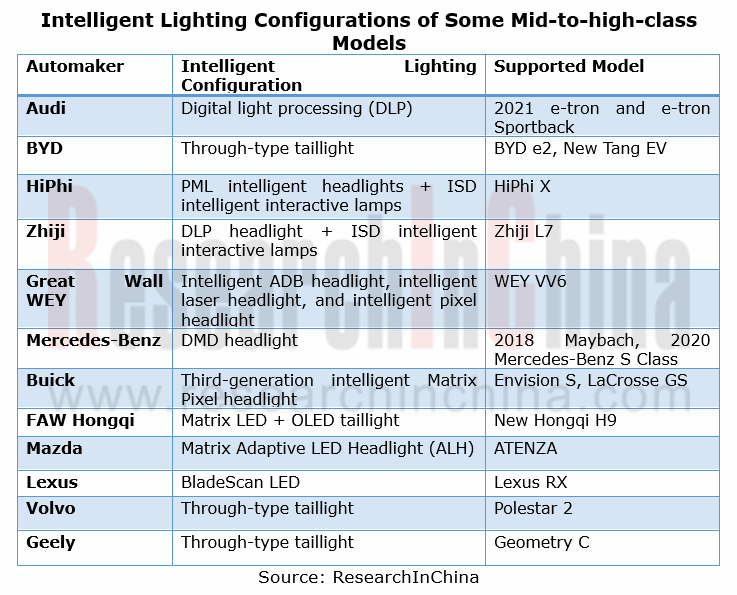
To meet market demand, automakers also step up their efforts to deploy intelligent lighting. Audi has made long and frequent deployments in automotive lighting. In June 2020, Audi released New Q5, a new model carrying Audi’s latest intelligent OLED lighting technology, which makes Audi the first automaker digitalizing taillights into a display. Audi is working to develop flexible digital OLED.
Among Chinese automakers, BYD has developed automotive lighting independently since 2003. FinDreams Vision Co., Ltd. BYD established in 2019 is devoted to developing vision technology, motor vehicle lighting and signal system. Having been the first automaker to integrate automotive lighting vertically, BYD is working toward development of new technologies in automotive lighting and environment interconnection.
In addition, Mazda has also developed its adaptive LED headlight (ALH) technology.
As the technology advances, automotive lighting is no longer a simple lighting tool but will integrate with driving assistance functions, for example, combined with cameras to enable safer driving through high and low beam switch according to the objects ahead. In future, more intelligent, more interactive and safer automotive lighting will be demanded in a new age.
Automotive Vision Industry Report, 2025
Automotive Vision Research: Average Camera Installation per Vehicle Reaches 5.2 Units, and Front-View Tricam Installation Exceeds 1.2 Million Sets.
From January to September 2025, the total installa...
Automotive Infrared Night Vision System Research Report, 2025
Automotive night vision research: The rise of infrared AEB, with automotive infrared night vision experiencing a 384.7% year-on-year increase from January to September.
From January to September 2025...
New Energy Vehicle Cross-Domain (Electric Drive System and Powertrain Domain) Integration Trend Report 2025-2026
Electric Drive and Powertrain Domain Research: New technologies such as three-motor four-wheel drive, drive-brake integration, and corner modules are being rapidly installed in vehicles.
Electric dri...
Analysis on Desay SV and Joyson Electronic's Electrification, Connectivity, Intelligence and Sharing, 2025
Research on Desay SV and Joyson Electronic: Who is the No.1 Intelligent Supplier?
Both Desay SV and Joyson Electronic are leading domestic suppliers in automotive intelligence. "Analysis on Desay SV ...
OEMs and Tier 1 Suppliers' Cost Reduction and Efficiency Enhancement Strategy Analysis Report, 2025
ResearchInChina released the "OEMs and Tier 1 Suppliers' Cost Reduction and Efficiency Enhancement Strategy Analysis Report, 2025", summarizing hundreds of cost reduction strategies to provide referen...
Automotive Fixed Panoramic Sunroof and Smart Roof Research Report, 2025
With the intelligent application of car roofs as the core, this report systematically sorts out a series of new products such as fixed panoramic sunroof/openable sunroof, ceiling screen, roof ambient ...
Automotive-Grade Power Semiconductor and Module (SiC, GaN) Industry Research Report, 2025
SiC/GaN Research: Sales volume of 800V+ architecture-based vehicles will increase more than 10 times, and hybrid carbon (SiC+IGBT) power modules are rapidly being deployed in vehicles.
Sales volume o...
Cockpit Agent Engineering Research Report, 2025
Cockpit Agent Engineering Research: Breakthrough from Digital AI to Physical AI
Cockpit Agent Engineering Research Report, 2025 starts with the status quo of cockpit agents, summarizes the technical ...
Prospective Study on L3 Intelligent Driving Technology of OEMs and Tier 1 Suppliers, 2025
L3 Research: The Window of Opportunity Has Arrived - Eight Trends in L3 Layout of OEMs and Tier 1 Suppliers
Through in-depth research on 15 OEMs (including 8 Chinese and 7 foreign OEMs) and 9 Tier 1 ...
China Commercial Vehicle IoV and Intelligent Cockpit Industry Research Report 2025
Commercial Vehicle IoV and Cockpit Research: The Third Wave of Passenger Car/Commercial Vehicle Technology Integration Arrives, and T-Box Integrates e-Call and 15.6-inch for Vehicles
I. The third wav...
Intelligent Vehicle Electronic and Electrical Architecture (EEA) and Technology Supply Chain Construction Strategy Research Report, 2025
E/E Architecture Research: 24 OEMs Deploy Innovative Products from Platform Architectures to Technical Selling Points
According to statistics from ResearchInChina, 802,000 passenger cars with domain...
Research Report on Intelligent Vehicle Cross-Domain Integration Strategies and Innovative Function Scenarios, 2025
Cross-Domain Integration Strategy Research: Automakers' Competition Extends to Cross-Domain Innovative Function Scenarios such as Cockpit-Driving, Powertrain, and Chassis
Cross-domain integration of ...
China Autonomous Driving Data Closed Loop Research Report, 2025
Data Closed-Loop Research: Synthetic Data Accounts for Over 50%, Full-process Automated Toolchain Gradually Implemented
Key Points:From 2023 to 2025, the proportion of synthetic data increased from 2...
Automotive Glass and Smart Glass Research Report, 2025
Automotive Glass Report: Dimmable Glass Offers Active Mode, Penetration Rate Expected to Reach 10% by 2030
ResearchInChina releases the Automotive Glass and Smart Glass Research Report, 2025. This r...
Passenger Car Brake-by-Wire (BBW) Research Report, 2025
Brake-by-Wire: EHB to Be Installed in 12 Million Vehicles in 2025
1. EHB Have Been Installed in over 10 Million Vehicles, A Figure to Hit 12 Million in 2025.
In 2024, the brake-by-wire, Electro-Hydr...
Autonomous Driving Domain Controller and Central Computing Unit (CCU) Industry Report, 2025
Research on Autonomous Driving Domain Controllers: Monthly Penetration Rate Exceeded 30% for the First Time, and 700T+ Ultrahigh-compute Domain Controller Products Are Rapidly Installed in Vehicles
L...
China Automotive Lighting and Ambient Lighting System Research Report, 2025
Automotive Lighting System Research: In 2025H1, Autonomous Driving System (ADS) Marker Lamps Saw an 11-Fold Year-on-Year Growth and the Installation Rate of Automotive LED Lighting Approached 90...
Ecological Domain and Automotive Hardware Expansion Research Report, 2025
ResearchInChina has released the Ecological Domain and Automotive Hardware Expansion Research Report, 2025, which delves into the application of various automotive extended hardware, supplier ecologic...